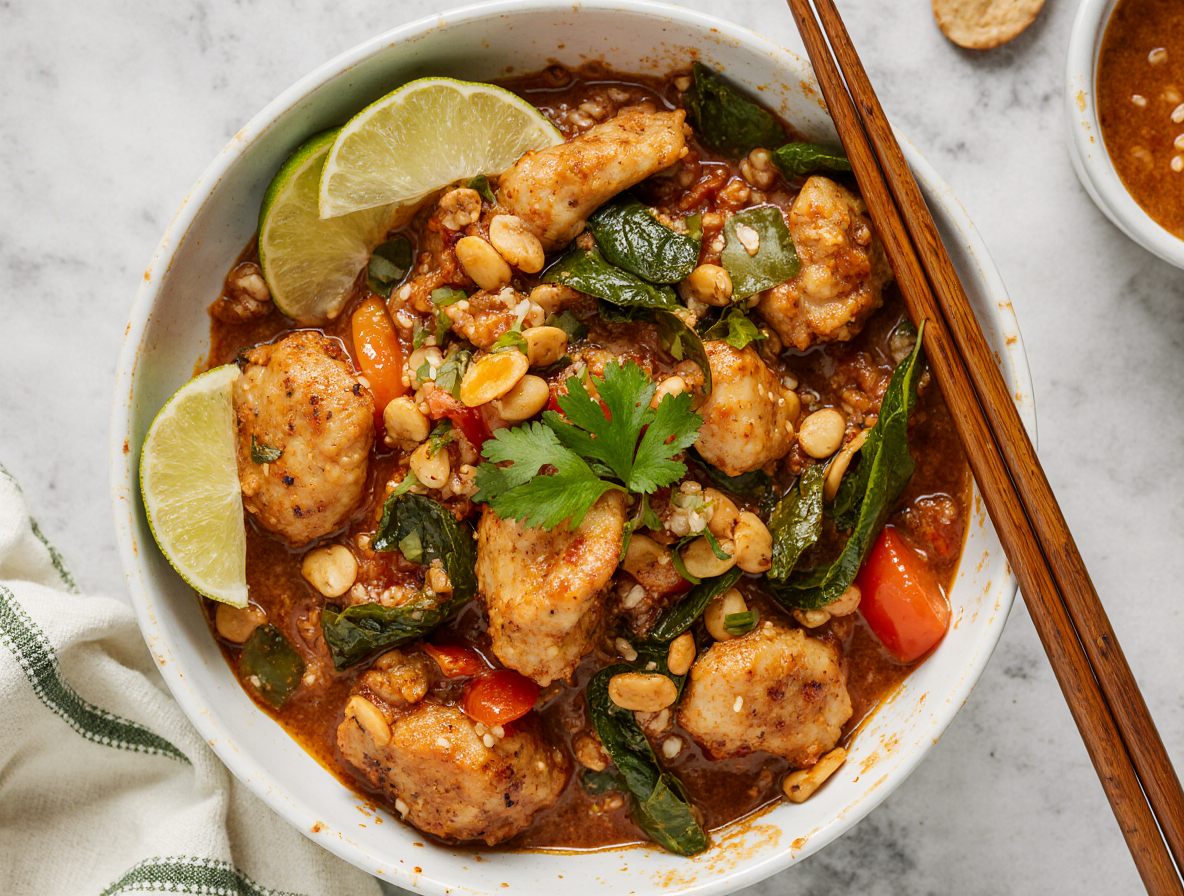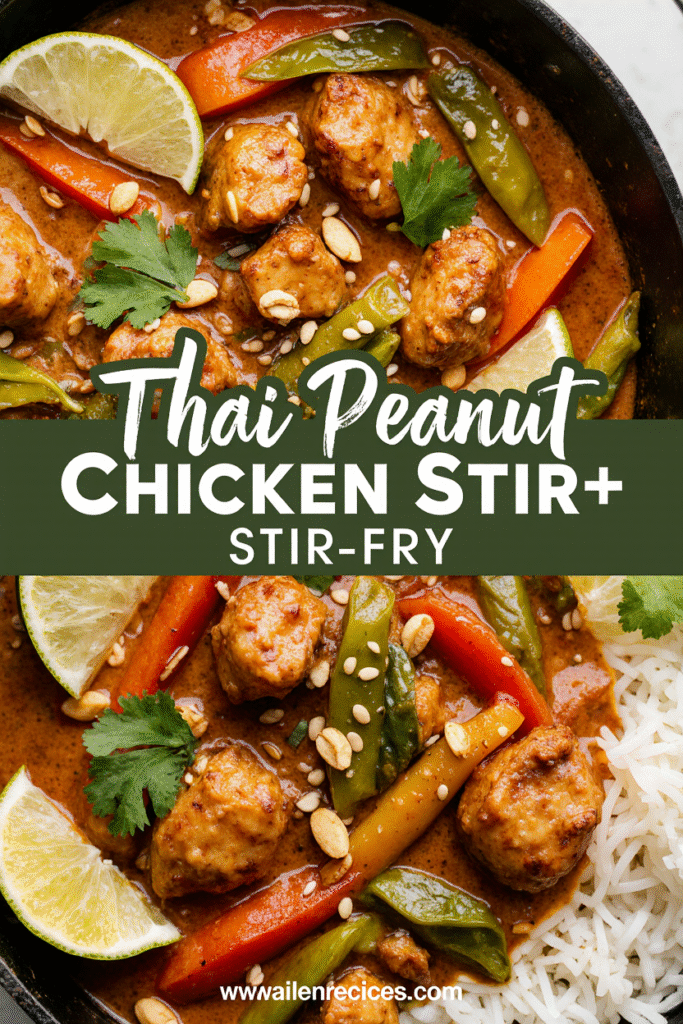The Secret to Perfect Thai Peanut Chicken Stir-Fry (Better Than Takeout!)
Thai peanut chicken stir-fry has become my go-to dinner solution for busy weeknights when I crave something rich and flavorful but don’t have hours to spend in the kitchen. In just 30 minutes, this dish delivers layers of sweet and spicy flavors that actually taste better than takeout.
What makes this peanut sauce stir fry so special is its incredible versatility. I love how this thai peanut chicken recipe combines tender chicken pieces with vibrant vegetables, all enveloped in an ultra-creamy peanut sauce brightened with ginger, garlic, sesame, and lime. Additionally, the chicken peanut stir fry can easily be made vegetarian by swapping the chicken for tofu, making it perfect for accommodating different dietary preferences. The thai peanut sauce chicken stir fry is equally delicious served over rice, with noodles, or even wrapped in lettuce leaves for a lighter option.
In this guide, I’ll share my secrets for creating the perfect chicken peanut sauce stir fry that will have you skipping takeout menus altogether. From selecting the right ingredients to mastering the cooking technique, you’ll learn everything you need to know to make this 30-minute meal a regular part of your dinner rotation.
Essential Ingredients for Thai Peanut Chicken Stir-Fry
The secret to creating the perfect thai peanut chicken stir-fry lies in selecting high-quality ingredients that work harmoniously together. Having prepared this dish countless times, I’ve discovered exactly which components deliver that authentic Thai flavor while keeping preparation simple.
Key components of the peanut sauce
The heart of any thai peanut chicken recipe is undoubtedly the peanut sauce. I start with ½ cup creamy peanut butter—natural varieties with just peanuts and salt work best for authentic flavor. Next, I add 2-3 tablespoons soy sauce (or fish sauce for extra umami) and 1-2 tablespoons brown sugar or honey for sweetness.
For that signature tang, a combination of 2 tablespoons lime juice and 1-2 tablespoons rice vinegar is essential. Furthermore, aromatics like 1 tablespoon each of minced fresh ginger and garlic provide depth, while 1-2 teaspoons of red pepper flakes add heat.
To achieve the perfect consistency, thin the mixture with either ¼ cup water or coconut milk—the latter adds richness that transforms the entire dish.
Best vegetables for stir fry
When selecting vegetables for chicken peanut stir fry, I prioritize those that maintain their crispness even after cooking. Bell peppers (particularly red) offer vibrant color and sweet flavor, whereas broccoli florets absorb the sauce beautifully.
Sugar snap peas provide crunch, specifically when added toward the end of cooking. Other excellent options include:
- Sliced carrots for sweetness and color
- Mushrooms for earthy flavor
- Napa cabbage or regular cabbage for volume
- Bean sprouts for freshness
The key is cutting everything into uniform, bite-sized pieces to ensure even cooking throughout the stir fry process.
Choosing the right chicken cut
For the most tender thai peanut sauce chicken stir fry, boneless skinless chicken thighs are my first choice. They remain juicy during the high-heat cooking process and offer more flavor than breast meat. However, if you prefer leaner protein, boneless skinless chicken breasts work well too.
The cutting technique significantly impacts the final texture. Always slice chicken against the grain into ¼-inch pieces to break down muscle fibers. For maximum tenderness, I recommend placing the chicken in the freezer for about 15 minutes before slicing—this firms up the meat, making it easier to cut precisely.
Optional toppings and garnishes
The final touch that elevates homemade peanut sauce stir fry above takeout is thoughtful garnishing. Chopped roasted peanuts provide essential crunch, while fresh herbs like cilantro and Thai basil add brightness.
Sliced green onions contribute freshness, and lime wedges allow diners to adjust acidity to taste. During cooler months, I occasionally incorporate bean sprouts for extra texture or a sprinkle of sesame seeds for nutty depth.
Step-by-Step Guide to Cooking the Stir-Fry
Mastering the cooking sequence is essential for a successful thai peanut chicken stir-fry that outshines any takeout. I’ve perfected this method through countless trials, ensuring each component maintains its optimal texture and flavor.
1. Prepare the peanut sauce
First, gather all sauce ingredients in a medium bowl. Whisk together peanut butter, water, honey or brown sugar, soy sauce, rice vinegar, minced ginger, minced garlic, and red pepper flakes until completely smooth. For a thinner consistency, add additional water tablespoon by tablespoon. Once thoroughly combined, set aside to allow flavors to meld together while preparing other components.
2. Cook the chicken until golden
Heat 1-2 tablespoons oil in a large wok or deep skillet over medium-high heat. Once the oil is hot, add minced garlic and ginger, sautéing just until fragrant, about 15-30 seconds. Next, add thinly sliced chicken pieces, ensuring not to overcrowd the pan. Season lightly with salt and pepper, then cook until the chicken is no longer pink and juices run clear, approximately 4-5 minutes. Transfer the cooked chicken to a clean plate and cover to keep warm.
3. Stir-fry the vegetables
Using the same pan, add another tablespoon of oil if needed. Thereafter, add your firmest vegetables first (carrots, broccoli, cauliflower) along with a splash of water to help them steam. Cook for 2-3 minutes, stirring frequently. Subsequently add medium-firm vegetables (bell peppers, mushrooms, snap peas) and continue stir-frying for another 1-2 minutes until crisp-tender. Finally, incorporate any quick-cooking vegetables like bean sprouts or leafy greens in the last 30 seconds.
4. Combine everything and simmer
Return the cooked chicken to the pan with the vegetables. Immediately pour the prepared peanut sauce over everything and toss gently to coat all ingredients evenly. Allow the mixture to simmer for 1-2 minutes until the sauce thickens slightly and clings to the chicken and vegetables. Shortly before removing from heat, stir in chopped peanuts and fresh herbs like cilantro. The finished thai peanut sauce chicken stir fry should be glossy with sauce that’s thick enough to coat everything without being overly runny.
Tips to Make It Better Than Takeout
What truly separates restaurant-quality thai peanut chicken stir-fry from homemade versions is attention to cooking technique. After years of trial and error, I’ve discovered several professional methods that transform an ordinary stir-fry into something extraordinary.
Use fresh aromatics like garlic and ginger
Fresh aromatics make all the difference in thai peanut chicken recipes. Indeed, infusing oil with minced garlic, ginger, and chili flakes before adding other ingredients allows their flavors to permeate the entire dish. I cook these aromatics over medium heat for 1-2 minutes until fragrant, essentially creating a flavored oil that carries these tastes throughout the stir-fry. Never add garlic midway through cooking—it won’t have time to release its full flavor.
Cook chicken in batches for better texture
High heat is absolutely critical for authentic stir-fry results. In essence, cooking chicken in small batches prevents overcrowding, which causes meat to steam rather than sear. This technique ensures each piece develops a golden exterior while remaining tender inside. For the most succulent chicken peanut stir fry, slice the meat against the grain into thin, uniform pieces.
Add sauce at the right time
The timing of sauce addition dramatically impacts your thai peanut sauce chicken stir fry. First of all, cook your proteins and vegetables separately, initially returning them to the pan only after both are properly cooked. At this point, add your peanut sauce and simmer just until thickened—about 1-2 minutes. Overcooking the sauce causes it to become too thick and lose its vibrant flavors.
Balance flavors with lime or vinegar
Beyond that, balancing the rich peanut sauce with acidity creates restaurant-worthy flavor depth. A splash of rice vinegar or fresh lime juice cuts through the richness and brightens the entire dish. Along with this, taste and adjust seasonings before serving—everyone’s preference for sweet-savory-spicy balance differs.
Double the sauce for leftovers
Given these points, I always make extra peanut sauce when preparing chicken peanut sauce stir fry. The sauce keeps refrigerated for several days and breathes new life into leftovers, which remain delicious for up to 4 days. Most importantly, store everything in airtight containers and reheat gently to preserve textures.
Customizations and Variations to Try
One thing I love about thai peanut chicken stir-fry is its incredible adaptability. Over time, I’ve experimented with countless variations to suit different dietary needs, ingredient availability, and personal preferences.
Make it vegetarian with tofu or chickpeas
Transforming peanut sauce stir fry into a vegetarian delight is remarkably simple. Extra firm tofu works exceptionally well as it holds its shape during cooking. I press it first to remove excess moisture, then cube and sauté until golden. Alternatively, chickpeas provide a protein-rich option that requires zero preparation—simply drain, rinse, and add them to your stir-fry. For additional variety, tempeh offers a nutty flavor that complements the peanut sauce beautifully. Most importantly, when using plant-based proteins, I marinate them briefly in the sauce beforehand to enhance flavor absorption.
Swap noodles for rice or quinoa
The base of your thai peanut chicken recipe can be easily varied depending on dietary preferences. Brown rice creates a heartier, more nutritious foundation compared to white rice. In contrast to traditional options, quinoa introduces a protein boost while maintaining a pleasing texture. Moreover, the noodle possibilities are extensive—try konjac noodles for a low-carb alternative, sweet potato noodles for a paleo-friendly option, or experiment with udon or soba for their distinctive textures. Each base absorbs the peanut sauce differently, creating subtle variations in the final dish.
Adjust spice level to taste
The heat in chicken peanut sauce stir fry is entirely customizable. To reduce spiciness, simply decrease or completely omit red pepper flakes from your sauce. For those seeking extra fire, incorporate sriracha, sambal oelek, or additional chili flakes. In fact, balancing heat with cooling ingredients like coconut milk creates complexity without overwhelming your palate. Alternatively, adding a touch more lime juice or vinegar can counterbalance intense spiciness while enhancing overall flavor.
Use frozen veggies for convenience
On busy weeknights, frozen vegetables can cut prep time in half without significantly compromising quality. Though they won’t remain quite as crisp as fresh options, they still absorb flavors beautifully. Together with your chosen protein, a 16-ounce package of frozen mixed vegetables makes a complete meal. I recommend thawing and patting them dry before adding to your thai peanut sauce chicken stir fry. Sturdy options like broccoli, carrots, cauliflower, and green beans hold up particularly well when frozen.
Conclusion
Thai peanut chicken stir-fry stands as a perfect weeknight solution that truly delivers restaurant-quality results at home. Throughout this guide, we’ve explored the essential components that make this dish shine – from the creamy peanut sauce balanced with lime and aromatics to the proper cooking techniques that ensure perfect texture.
The beauty of this dish lies not only in its incredible flavor but also in its adaptability. Whether you prefer chicken thighs or breasts, want to substitute tofu for a vegetarian option, or need to use frozen vegetables on busy nights, this recipe accommodates your needs without sacrificing taste. Additionally, the base can easily shift between rice, noodles, or even lettuce wraps depending on your dietary preferences.
The key takeaway from perfecting this dish certainly comes down to technique. Cooking proteins in batches, adding sauce at precisely the right moment, and balancing flavors with acidity all contribute to results that surpass takeout versions. Furthermore, these techniques apply to countless other stir-fry recipes, expanding your weeknight dinner repertoire significantly.
Next time takeout cravings strike, remember this 30-minute meal waiting in your culinary arsenal. The satisfaction of creating something this delicious at home far exceeds the temporary convenience of delivery. Unlike restaurant versions, your homemade creation allows complete control over ingredients, spice levels, and nutritional content.
The perfect Thai peanut chicken stir-fry ultimately becomes more than just dinner—it transforms into a culinary achievement that proves restaurant-quality meals can happen regularly in your kitchen. After mastering this recipe, you’ll find yourself reaching for the takeout menu less frequently, saving money while enjoying fresher, more flavorful meals tailored exactly to your taste.
FAQs
Q1. What are the key ingredients in Thai peanut sauce for stir-fry? The main components of Thai peanut sauce include creamy peanut butter, soy sauce, brown sugar or honey, lime juice, rice vinegar, minced ginger and garlic, and red pepper flakes. For added richness, coconut milk can be used to thin the sauce.
Q2. Which vegetables work best in a Thai peanut chicken stir-fry? Vegetables that maintain their crispness work well, such as bell peppers, broccoli florets, sugar snap peas, sliced carrots, and mushrooms. For added freshness, you can include bean sprouts or cabbage. The key is to cut all vegetables into uniform, bite-sized pieces for even cooking.
Q3. How can I make my homemade Thai peanut chicken stir-fry better than takeout? To elevate your stir-fry, use fresh aromatics like garlic and ginger, cook chicken in batches for better texture, add the sauce at the right time, balance flavors with lime or vinegar, and consider making extra sauce for leftovers. These techniques help achieve restaurant-quality results at home.
Q4. Can I make Thai peanut chicken stir-fry vegetarian? Absolutely! You can easily make it vegetarian by substituting chicken with extra-firm tofu, chickpeas, or tempeh. These plant-based proteins work well with the peanut sauce and can be marinated beforehand to enhance flavor absorption.
Q5. How can I adjust the spice level in Thai peanut chicken stir-fry? The heat level is customizable. To reduce spiciness, decrease or omit red pepper flakes from the sauce. For extra heat, add sriracha, sambal oelek, or additional chili flakes. You can also balance intense spiciness by adding more lime juice or a touch of coconut milk.


